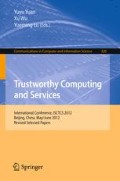Abstract
A CAPTCHA is a test designed to distinguish computer programs from human beings, in order to prevent the abuse of network resources. And nowadays, academic researches on CAPTCHA, including designing friendly but secure CAPTCHA systems and breaking existing CAPTCHA systems, are becoming a more and more hot topic. Breaking an existing CAPTCHA system can help to perfect its designs and therefore to improve its security. In this paper, ESBDA, an Ellipse-Shaped Blobs Detection Algorithm, is proposed to detect the ellipse-shaped blobs used in Facebook CAPTCHA scheme, which can be used to break the Facebook CAPTCHA system. The approach is based on detecting the contour of the ellipse-shaped blobs on the basis of erosion and dilation technologies. And the experimental results show that ESBDA can effectively remove the noised ellipse-shaped blobs in the Facebook CPATCHA scheme.
Access this chapter
Tax calculation will be finalised at checkout
Purchases are for personal use only
Preview
Unable to display preview. Download preview PDF.
References
von Ahn, L., Blum, M., Langford, J.: Telling Humans and Computer Apart Automatically. CACM 47(2) (2004)
Chellapilla, K., Larson, K., Simard, P., Czerwinski, M.: Computers beat humans at single character recognition in reading-based Human Interaction Proofs. In: 2nd Conference on Email and Anti-Spam, CEAS (2005)
Simard, P., Steinkraus, D., Platt, J.: Best Practice for Convolutional Neural Networks Applied to Visual Document Analysis. In: International Conference on Document Analysis and Recognition (ICDAR), pp. 958–962. IEEE Computer Society, Los Alamitos (2003)
Simard, P., Szeliski, R., Benaloh, J., Couvreur, J., Calinov, I.: Using character recognition and segmentation to tell computers from humans. In: International Conference on Document Analysis and Recognition, ICDAR (2003)
Yan, J., El Ahmad, A.S.: A Low-cost Attack on a Microsoft CAPTCHA (2008)
Huang, S.-Y., Lee, Y.-K., Bell, G., Ou, Z.-H.: An efficient segmentation algorithm for CAPTCHA with line cluttering and character warping (2009)
Yan, J., El Ahmad, A.S.: Breaking Visual CAPTCHA with Naïve Pattern Recognition Algorithms (2007)
von Ahn, L., Blum, M., Langford, J.: Telling Humans and Computer Apart Automatically. CACM 47(2) (2004)
Chellapilla, K., Simard, P.: Using Machine Learning to Break Visual Human Interaction Proofs. In: Neural Information Processing Systems (NIPS). MIT Press (2004)
Yan, J., El Ahmad, A.S.: A Low-cost Attack on a Microsoft CAPTCHA. School of Computing Science Technical Report, Newcastle University, England (2008)
Pope, C., Kaur, K.: Is It Human or Computer? Defending E-Commerce with CAPTCHA. IEEE IT Professional, pp. 43–49 (March 2005)
Yan, J., El Ahmad, A.S.: Usability of CAPTCHAs - Or,Usability issues in CAPTCHA design. In: The Fourth Symposium on Usable Privacy and Security, Pittsburgh, USA (July 2008)
Yan, J.: Bot, Cyborg and Automated Turing Test. In: The Fourteenth International Workshop on Security Protocols, Cambridge, UK (March 2006)
Baird, H.S., Bentley, J.L.: Implicit CAPTCHAs. In: Proceedings of Document Recognition an Retrieval XII, pp. 191–196 (2005)
Huang, S.Y., Lee, Y.K., Bell, G., Ou, Z.H.: A projection-based segmentation algorithm for breaking MSN and YAHOO CAPTCHAs. In: Proceedings of the 2008 International Conference of Signal and Image Engineering (ICSIE 2008), London, UK (2008)
Moy, G., Jones, N., Harkless, C., Potter, R.: Distortion estimation techniques in solving visual CAPTCHAs. In: Proceedings of the 2004 IEEE Computer Society Conference on Computer Vision and Pattern Recognition, vol. 2, pp. 23–28 (2004)
Chellapilla, K., Simard, P.: Using machine learning to break visual human interaction proofs (HIPs). In: Saul, L.K., Weiss, Y., Bottou, L. (eds.) Advances in Neural Information Processing Systems 17, pp. 265–272. MIT, Cambridge (2005)
Author information
Authors and Affiliations
Editor information
Editors and Affiliations
Rights and permissions
Copyright information
© 2013 Springer-Verlag Berlin Heidelberg
About this paper
Cite this paper
Liu, P., Shi, J., Wang, L., Guo, L. (2013). An Efficient Ellipse-Shaped Blobs Detection Algorithm for Breaking Facebook CAPTCHA. In: Yuan, Y., Wu, X., Lu, Y. (eds) Trustworthy Computing and Services. ISCTCS 2012. Communications in Computer and Information Science, vol 320. Springer, Berlin, Heidelberg. https://doi.org/10.1007/978-3-642-35795-4_53
Download citation
DOI: https://doi.org/10.1007/978-3-642-35795-4_53
Publisher Name: Springer, Berlin, Heidelberg
Print ISBN: 978-3-642-35794-7
Online ISBN: 978-3-642-35795-4
eBook Packages: Computer ScienceComputer Science (R0)

